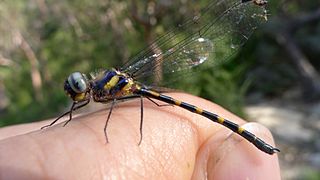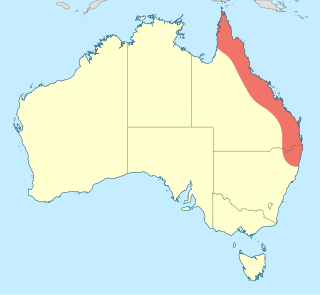
The Platycnemididae are a family of damselflies. They are known commonly as white-legged damselflies. There are over 400 species native to the Old World. The family is divided into several subfamilies.

Austrocordulia is a genus of dragonfly in the superfamily Libelluloidea, endemic to northern and eastern Australia. Species of Austrocordulia are medium-sized, dark-coloured dragonflies, either brown or black with yellow markings.

Lathrocordulia is a genus of dragonfly in the superfamily Libelluloidea, endemic to Australia. Species of Lathrocordulia are medium-sized, bronze to black dragonflies without pale markings,
Protoneuridae was formerly considered a family of damselflies. Recent taxonomic revisions have classified the species previously placed in Protoneuridae into two existing families - Coenagrionidae and Platycnemididae, both in the superfamily Coenagrionoidea.

Archaeophya is a small genus of dragonflies assigned to the superfamily Libelluloidea. Species of Archaeophya are large dragonflies with metallic-coloured bodies, dark with yellow spots, and clear wings. They only occur in eastern Australia.

Platystictidae is a family of damselflies, commonly known as shadowdamsels. They look very similar to the threadtail damselfly family (Protoneuridae). They can mostly be found throughout Asia, Central America, and South America.

The Synthemistidae are the family of dragonflies commonly known as tigertails, or sometimes called southern emeralds. This family is part of the superfamily Libelluloidea.

Aeshnoidea is a superfamily of dragonflies that contains two extant families, Aeshnidae and Austropetaliidae.

Cordulegastroidea is a superfamily of dragonflies that contains three families.

Libelluloidea is a superfamily of dragonflies.

Cordulephya is a genus of dragonflies assigned to the superfamily Libelluloidea, and endemic to eastern Australia. The species are small to tiny in size, coloured black, or purplish-black, with yellowish markings. Unusually for Anisoptera, these dragonflies rest with their wings folded above their body in a similar manner to many species of damselfly. They are commonly known as shutwings.
Cordulephyidae was formerly considered a distinct family of dragonflies occurring in Africa and Australia. Recent taxonomic revisions have classified the species previously placed in Cordulephyidae to now be within the superfamily Libelluloidea.
Up until recently, Lindeniidae was considered a family of dragonflies occurring in Australia. It is no longer recognised.
Austrocorduliidae was formerly considered a family of dragonflies occurring in South Africa and Australia. Recent taxonomic revisions have classified the species previously placed in Austrocorduliidae to now be within the superfamily Libelluloidea.

Hesperocordulia is a genus of dragonflies in the superfamily Libelluloidea, endemic to south-western Australia.

Micromidia is a genus of dragonflies in the superfamily Libelluloidea. They are small to medium-sized dragonflies, coloured black or metallic green with pale markings, and endemic to eastern Australia.

Austrophya is a genus of dragonflies in the superfamily Libelluloidea, endemic to north-eastern Australia.
Gomphomacromiidae was formerly considered a distinct family of dragonflies occurring in Chile and Australia. Recent taxonomic revisions have classified the species previously placed in Gomphomacromiidae to now be within the superfamily Libelluloidea.

Pseudocordulia is a small genus of dragonflies endemic to tropical northeastern Australia. They are medium-sized, bronze-black dragonflies with clear wings.














